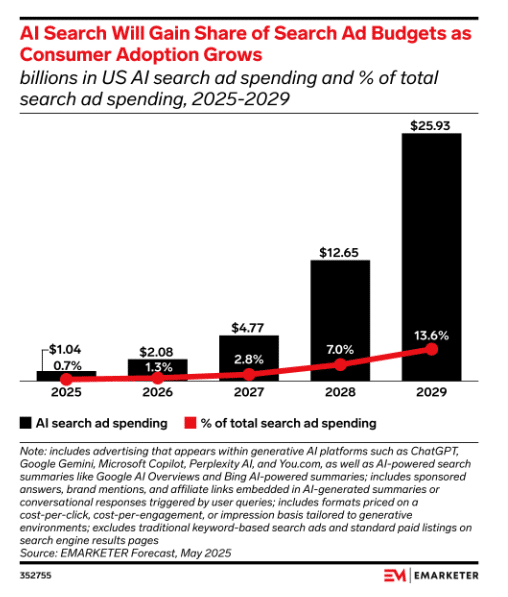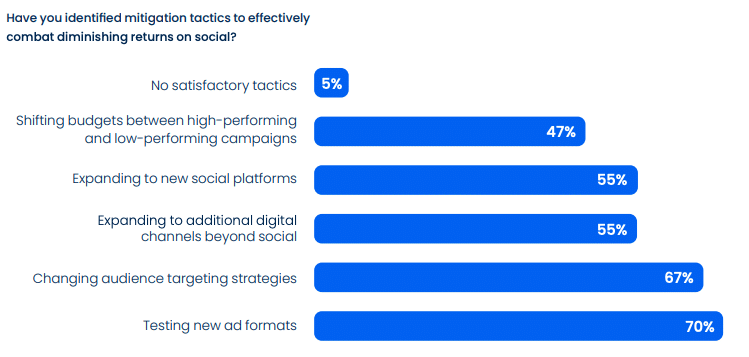- Trend 1: The Rise of Personalized Customer Experiences in Insurance
- Trend 2: Leveraging AI and Automation in Insurance Advertising
- Trend 3: The Growing Importance of Digital Channels and Omnichannel Strategies in Insurance
- Trend 4: Content Marketing and Building Trust in the Insurance Sector
- Trend 5: Data Privacy and Regulatory Changes Impacting Insurance Digital Advertising
- Key Takeaways
- Frequently Asked Questions (FAQs)
The insurance industry has always been competitive, challenging brokerages and agents to stand out. The ever-changing landscape of digital advertising only complicates things for insurance professionals: With rising customer expectations, tighter data privacy regulations, and soaring acquisition costs, insurance marketers must rethink the way they reach and convert audiences.
In 2025, it’s important for insurance marketers to meet customers where they are. Here are some of the top trends shaping insurance marketing this year.
Taboola's Finance Advertising Creative Playbook 2025
Trend 1: The Rise of Personalized Customer Experiences in Insurance
Personalization has gone from being a “nice to have” to a non-negotiable in insurance marketing. Customers have begun to expect tailored offers at each step of the buying journey. Here are some ways insurers are personalizing the customer experience:
Hyper-Personalization Using Data
Traditionally, advertisers have relied on demographics to personalize ads, but privacy concerns around third-party data have dampened that strategy. Instead, savvy marketers have shifted toward using first-party data and behavioral insights to deliver personalized messaging across multiple channels. Instead of demographics, insurance marketers now harness:
- Behavioral signals: These data points are based on user actions, such as page scroll depth and time on site.
- Intent data: Brands can look at user behavior to predict when people may be actively considering something they sell.
- Custom landing pages: Dynamic landing pages adjust based on the visitor. That means customers see information that matches their interests.
Insurance can be an emotional purchase: Consumers want to know they can trust a company to follow through if they ever have to file a claim. Personalization helps you earn trust even with customers who are still in the early stages of shopping for plans.
The power of personalization is increasingly showing up in consumer preference surveys, too. Here are a few stats that show the importance of personalizing the insurance experience:
- Personalizing marketing efforts can increase an insurer’s customer retention by 20%.
- Two out of five U.S. insurance customers will switch providers over a lack of personalization or trust.
- Customers are more willing to share their personal data with a brand they trust to use it responsibly.
By personalizing your insurance marketing, you reduce friction for customers researching various options by offering only the most relevant information. Customers face a long, multi-touchpoint journey on their way to a purchase, and will shop around to find the best ideal, making it more important than ever to capture their attention quickly.
You also have the ability to demonstrate empathy as a brand. For instance, if someone is shopping renter’s insurance for a first apartment, you have the opportunity to deliver messaging that mentions that user’s pain points.
As valuable as personalization can be, it comes with an important caveat: Brands need to balance the value of personalization with the demand for data privacy. You can do this by having transparent data-use policies and making it easy for customers to opt out.
Trend 2: Leveraging AI and Automation in Insurance Advertising
Artificial intelligence (AI) is transforming the way insurance marketers operate. Instead of working for hours, crafting individual campaigns for different audiences, you can invest in innovative solutions that boost efficiency, sharpen your targeting, and unlock new creative potential for lead generation.
Some top stats on AI and automation in insurance include:
- 82% of insurers surveyed say AI adoption is critical.
- 79% of principal agents plan to adopt or already use AI in their business.
- AI-driven search ad spending is expected to grow from just over $1 billion in 2025 to nearly $26 billion by 2029.

Source: EMARKETER
Here are some top ways insurance brands are using AI and automation to track down new customers.
AI-Powered Automation
Both insurers and marketers are increasingly incorporating AI into their lead generation processes. One of the biggest ways the technology can help you is in refining your audience targeting: Instead of targeting based on demographics and historical data, AI can base targeting on real-time browsing behavior to ensure you reach customers based on what they’re interested in now, not three months ago. It can even predict future behavior, to a certain extent.
AI can also supercharge your ad bids. By adjusting your bids in real time, AI can more effectively manage conversions and lower your acquisition cost, making your ads more efficient. French insurance company GMF, for example, utilized the AI-powered Maximize Conversions bidding solution, alongside the implementation of first-party data for targeting, to see an 82% increase in lead volume — 134% above their stated goal.
Lastly, AI tools can help you seek out the best ad creatives. You can test various approaches, then optimize and scale based on how your creatives are performing. As a bonus, you’ll gather data that can help you create more effective ad creatives moving forward.
One example of AI-powered testing is Progressive Insurance, which used generative AI to test ad variants, producing 96 audio variants in only two weeks. As a result, the company increased quote initiations by 31%. In the end, though, 96 variants proved to be excessive, making it tough for the AI to model data accurately.
Chatbots and Virtual Assistants
As your ads bring in leads, you’ll need representatives to respond and answer any questions people may have. Paying someone to do this job can cut into your budget, but technology has created an easier way.
In 2025, savvy marketers are leaning into tools like chatbots and virtual assistants (known as “AI agents”) to prequalify prospects as they come through their landing pages. These tools also come in handy for scheduling agent consultations and walking users through quote comparisons. While they’re no replacement for an experienced agent, technology can handle lower-level customer interactions, freeing up agents to focus on setting up coverage and interacting with existing policyholders.
GEICO has hopped headfirst into the technology, building a chatbot into its mobile app. Policyholders can request information on coverage, view billing information, access documents like proof of insurance cards, and more.
Predictive Analytics
AI doesn’t just help with automation, it can also predict which users are most likely to convert and which offer will work best for a specific customer. In addition to knowing the “who” and “what” of ad placement, AI can also be used for timing, since the right tools will serve ads to a user at the optimal time to boost the chances of converting.
As marketers shift from targeting by identity to targeting based on intent, it’s essential for insurance marketers to have the right tools in place. These tools will help you reach the right prospects without violating user privacy.
Predictive analytics can also be used to assess your marketing campaigns. One example of this is Lemonade, which used the Bayesian marketing mix modeling to gather data on all of its marketing activities. This holistic approach allows the insurer to identify which marketing channels are most effective to help predict future performance.
While AI-based tools have made marketing easier, they do come with some challenges. Insurers face both implementation cost and a learning curve in making the switch to these tools, as well as the extra steps involved in ensuring compliance with a regulated vertical like insurance. As they become more popular, marketers also risk over-relying on them. It’s essential to pair these solutions with human expertise to get the best results.
It’s important to continuously monitor the performance of any AI-driven strategy. These ongoing audits will ensure the technology aligns with your goals and your customers’ expectations.
Trend 3: The Growing Importance of Digital Channels and Omnichannel Strategies in Insurance
Consistency is key when insurers are communicating with customers. The predictability serves as a comfort, whether they’re getting an insurance quote or comparing one provider against another.
Paid reach on search and social platforms is more expensive than ever, and prices are only continuing to rise. For that reason, many marketers are putting effort into interactive ad formats, which tend to better engage prospects.
Some key stats impacting omnichannel strategies include:
- 78% of insurers plan to increase budgets for tech spending in 2025. Priorities were, in order: AI, big data and analytics, and cloud and digital infrastructure.
- 50% of insurance shoppers start their search on mobile devices.
- Insurance is increasingly being purchased online. 47% of all insurance buyers now purchase using digital channels.
It’s important to note that even though insurance shoppers often start researching on mobile, the journey doesn’t end there. Top insurers are turning to omnichannel implementation, starting with digital ads and funneling users to personalized landing pages, then nurturing them through email and having an agent follow up to close the deal.
Marketing doesn’t stop once you’ve won over a customer, though. By using tools like SMS reminders for policy renewals, you can ensure a policyholder sticks around from one year to the next.
While many things about insurance marketing are standard to marketing in general, there are some factors that make it stand out. Here are some key touchpoints in the customer journey when shopping for a new policy:
- Awareness: You want to make a good impression on new customers, and for that, few things work as well as display ads. The right ad creative can grab a prospect’s attention.
- Consideration: Once a customer knows about your brand, it’s time to progress to the research phase. Comparison tools and dynamic ad creatives can help you educate consumers and convince them to make a purchase.
- Decision: Sign-ups should be as easy as possible to keep interested customers moving forward. Seamless mobile quote forms and AI chat support can equip you with what you need to convert a prospect into a customer.
- Retention: Keeping existing customers on board is important, too. Personalized renewal messages and loyalty messaging can maintain engagement with your current policyholders.
Even the best marketing campaigns can fall apart. Disconnects between online and offline experiences aren’t uncommon, but there are some things brands can do to keep things consistent both online and off. Make sure you use consistent messaging across channels, and check that your online quotes include a save feature. This will allow a prospect to continue a quote on a different device.
Don’t forget mobile: Consumers are increasingly browsing on mobile versus desktop, making it important that brands have mobile-friendly websites. Make sure your forms are both short and tap-friendly and that your websites have fast load times. If you encourage customers to call to get or finish an insurance quote, click-to-call is essential in a mobile-centric world.
Trend 4: Content Marketing and Building Trust in the Insurance Sector
Trust is essential in insurance. Customers need that extra layer of comfort before signing a contract, so for that reason, content marketing has become a staple in the industry. The right content helps educate customers and establish your brand as an authority. Here are some ways to build authority and foster trust for your insurance brand in 2025:
- How-to guides.
- Interactive quizzes.
- Customer testimonials.
- Premium and deductible calculators.
- Thought leadership articles on industry changes.
- Videos and blogs told from the perspective of licensed agents.
A few trends are shaping the type of content that’s landing in 2025. Interactive carousels and dynamic question-and-answer content can capture short attention spans and make customers feel as though they’re part of your brand. Also of note:
- 70% of marketers surveyed are experimenting with new ad formats.
- Although 86% of consumers say they understand their insurance coverage, they fell short when tested on specific coverage areas.

Source: Taboola
For insurance marketers, investing in diverse formats should be a priority. Interactive tools like premium calculators and educational articles can be ways to attract and engage customers.
Search engine optimization (SEO) is another area of marketing that’s always changing. For insurance marketers, remaining competitive means tweaking your strategy for the techniques working best in 2025. That includes:
- Long-tail queries: Phrases like “best health insurance for recent college graduates” will gain more traction than “best health insurance.”
- Hyper-localization: If you can dominate a relevant local market or two, you’ll be able to capture more attention than going for a nationwide market. Keyphrases like “homeowners insurance San Diego” will help you gain visibility in those local markets.
- Voice search optimization: Today’s customers search using voice. By structuring your pages for Google’s featured snippets and voice search, you can gain a competitive edge.
- AI search: With growing numbers of people either searching directly through platforms like ChatGPT, or relying on Google’s AI snippets, tailoring content to be picked up by these tools is also critical for success.
Another trend dominating content marketing in 2025 is video. Insurance can be an especially complex issue, and videos can help demystify various topics. DirectAsia used short-form video as part of a larger strategy that generated more than 2,000 leads in just a six-month period. Best of all, the company reduced its cost per lead by more than half.
Realize's advanced AI capabilities enable precise targeting, engagement optimization, and budget simulation, maximizing advertiser ROI.
Trend 5: Data Privacy and Regulatory Changes Impacting Insurance Digital Advertising
Privacy has become a hot topic in recent years, and in 2025, consumers are more aware than ever of their rights. Insurers handle sensitive information, so it’s important to be aware of the key regulations and how they’re changing in 2025.
- General Data Protection Regulation (GDPR): This data protection law applies to residents in the European Union (EU). It’s stricter than U.S. law, so it’s important that any insurers with EU operations stay on top of it.
- California Consumer Privacy Act of 2018 (CCPA): California residents are protected under this law, which gives them control over how their data is collected and used. In 2025, increased fines and penalties will heighten pressure on businesses to remain compliant.
- Gramm–Leach–Bliley Act (GLBA): This federal law ensures companies offering financial products — including insurance — disclose information-sharing practices and offer opt-out options for sharing personal information.
- New state privacy laws: Four states now have privacy laws that impact marketers across all industries. If you market to consumers in Virginia, Colorado, Connecticut, or Utah, bone up on the new regulations to avoid hefty fines.
- American Privacy Rights Act: This proposed legislation will impose privacy regulations at the federal level. While it’s not in place yet, it’s important to keep an eye on it as you’re planning future data collection processes.
As privacy laws continue to tighten, insurance marketers have been challenged to find new ways to target consumers. Here are some statistics on how privacy is affecting insurance marketers in 2025:
- Currently 20 states have comprehensive data privacy laws in place.
- As of late 2024, privacy laws protect 6.3 billion people, which is 79% of the global population.
- 80% of respondents prefer transparency on how their data is used in digital ads, while 62% feel “creeped out” at the thought of being tracked online.
Privacy regulations limit use of third-party cookies and cross-site tracking without consent. Advertisers also now struggle with retargeting, since these regulations limit the use of personal identifiers.
Complicating matters is third-party cookie deprecation, which has some platforms disabling cookie use altogether. Other platforms, including Google, are making it easier for consumers to stop tracking on their own. This has driven marketers toward delivering ads based on a user’s current activity (contextual tracking) and actions on a site (behavioral intent signals).
For insurance marketers, privacy protections are even more important. Consumers prioritize trust when looking for an insurance policy, and behavior that might be seen as shady or invasive can erode that trust.
To thrive in a privacy-first world, insurers should:
- Use clear, concise consent language.
- Make it easy for consumers to choose which data to share.
- Regularly audit data partners for compliance.
- Lean into tools that predict instead of track.
- Offer a gift in exchange for contact information (i.e., calculators, informational content).
Key Takeaways
Personalized insurance marketing is no longer optional, but AI-powered tools make it easier for brands to use contextual tracking and behavioral intent signals to target prospects. With many consumers now starting their insurance search on mobile, a seamless omnichannel approach is crucial, but it’s important to build in privacy protections in everything you do. Insurance is one industry where trust-building is essential, and brands can do that through the content they create and present to consumers.
Frequently Asked Questions (FAQs)
What are the most effective digital advertising channels for insurance in 2025?
In 2025, performance display advertising dominates, and brands are taking creatives to the next level. Carousel ads and vertical videos engage today’s users more than traditional native placements. While marketers still rely heavily on search and social, rising costs have driven marketers to look for more affordable ways to stand out in the crowded insurance market. Short-form video and mobile-optimized clicks are especially popular with insurance marketers in 2025, providing a way to capture user attention and boost their cost per acquisition (CPA).
How can digital advertisers measure the ROI of their insurance marketing campaigns?
Tracking return on investment (ROI) is an important part of optimizing your budget, but marketers need to look at a variety of metrics to get the full picture. CPA and cost per lead are important, along with overall customer acquisition cost, quote-to-policy conversion rates, and the lifetime value of each acquired customer. Top-performing insurers rely heavily on all-in-one platforms that can connect the dots between ad spend, user engagement, and policy enrollment, making it easier to keep an eye on the entire customer journey.
What are some common mistakes to avoid in insurance digital advertising?
The biggest mistakes in insurance digital advertising can be tied back to customer experience. Overcomplicated enrollment forms that aren’t mobile-friendly will lose many prospects almost as soon as you attract them. Another mistake brands make is failing to hyper-personalize advertising efforts, which can make ads feel generic. Since building trust is important in advertising, failing to comply with data regulations is a big no-no. Lastly, relying on third-party tracking data in today’s privacy-conscious environment can lead to outdated information that impacts your ROI.
What are the key performance indicators (KPIs) for successful insurance digital marketing?
In many ways, insurance marketing doesn’t differ from marketing in other industries. Marketers still need to focus on click-through rate, time spent on page, cost per lead, and return on ad spend. Insurance marketers should also monitor conversion rates on quote forms, policy signups, and policyholder retention. Platforms that track these metrics while building in AI optimization can help you identify which audiences and creatives bring the best return.
How is the rise of insurtech companies influencing digital advertising strategies in the insurance industry?
The global insurtech market is experiencing massive growth, and that’s good news for insurance marketers. Today’s top insurtech companies offer seamless, mobile-first experiences and highly educational content. To remain competitive, more traditional insurers have found they need to step up their game, investing in performance-focused tools that automate testing and targeting. These tools help level the playing field, allowing even smaller insurance providers to compete.



